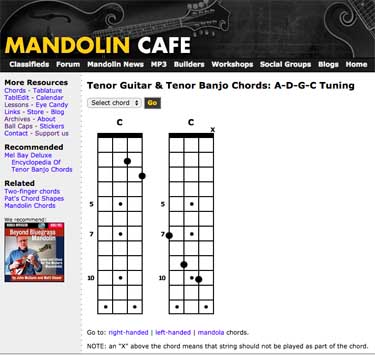« What makes a jazz mandolin |
Main
| Best of JM: 'I vi ii7 V7' 3-note chord blocks »
 February 5, 2015 | Tenor Guitar & Tenor Banjo Chords February 5, 2015 | Tenor Guitar & Tenor Banjo Chords
We've been digging into variations of the 5ths tuned tenor range incarnations of the mandolin family. CGDA is a great register for accompaniment and offers a much more interesting partnership with voice and soprano instruments. You can always play higher up the fretboard, but a mandolin can never play lower than a G.
Many may not be aware that the mandolin's bigger sister, the mandola is tuned the same as a tenor guitar and (Irish) tenor banjo. There is a rich tradition of both these instruments in mid early 20th century ensembles, banging out rhythm and often setting up a rich, sonorous harmonic foundation--often with just 3 or 4-note chords.
Tenor banjo/guitar books can help introduce chords to mandola, but an important consideration is scale. The tenor guitar scale can be as long as 23-26", and the mandola is generally 16-1/2 to 18", with the tenor banjo somewhere in between. Don't expect every chord to work identically from mandola to tenor--that fret span can be a killer on the fingers.
Check out the beta version of the Mandolin Cafe's latest expansion of mandolin and mandola chords into the tenor banjo and guitar. They are tuned the standard CGDA (not Octave GDAE). We recommend trying to learn these the same way you first learned mandolin chords. Begin simply, chords with just a few variations, but learn them as simple patterns of block finder movement. Avoid thinking "one 5th lower than mandolin" or transposing notes down a 5th. Think of it as 'that chord' until it becomes automatic.
Visit Cafe Link: Tenor Guitar & Tenor Banjo Chord Generator

You might notice some of the "Bluegrass" fingerings are conspicuously absent, the infamous "G-chop," for example. The simple reason is the fretspan is unattainable for most human hands. Another good reason is doubling the 3rd of the chord in this register sounds horrible.
Another thought--if you're tackling learning a 5-string mandolin, we suggest taking the approach of conceptualizing this as a mandola with extension--a high E string. Don't think mandolin with range a 5th lower. Try learning it the same way you first learned the mandolin, a few chords at a time on some simple, familiar songs. Eventually they become automatic.
CDGA is your base. E is the extension
Further:
Mandolin Family Specs
Resources for Mandola
Sample Stock ii V7 I Mandola Chord Fingerings
5-string Mandolin Chord Sets: Major 'ii7 V7 I"
Posted by Ted at February 5, 2015 9:38 PM

Disclaimer: In the 'Information Age' of the 21st Century,
any fool with a computer, a modem, and an idea can
become a self-professed 'expert." This site does not
come equipped with 'discernment.'
|



